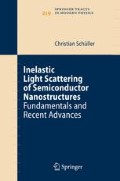Abstract
A semiconductor microcavity is an optical resonator, where the mirrors consist of alternating layers of two different semiconductors with different refractive indices, e.g., GaAs and AlAs, which have thicknesses of a quarter wavelength each. The resonator itself is called spacer, and has a thickness of a few half wavelengths. The electric fields of the light waves, and hence the light–matter interaction can be modified significantly inside a microcavity. In the past decades, a number of sophisticated experiments have been reported that took advantage of the strongly enhanced electric field inside the spacer of a planar semiconductor microcavity. A prominent example is the enhanced exciton–photon coupling, resulting in an enlarged Rabi splitting, in planar microcavities containing undoped quantum wells [1]. Subsequently, a wealth of theoretical and experimental work on exciton polaritons in semiconductor microcavities, e.g., about the influence of a magnetic field [2], or coupling between different microcavities [3], followed.
Access this chapter
Tax calculation will be finalised at checkout
Purchases are for personal use only
Preview
Unable to display preview. Download preview PDF.
References
C. Weisbuch, M. Nishioka, A. Ishikawa, and Y. Arakawa: Phys. Rev. Lett. 69, 3314 (1992)
J. Tignon, P. Voisin, C. Delalande, M. Voos, R. Houdre, U. Oesterle, and R. P. Stanley: Phys. Rev. Lett. 74, 3967 (1995)
R. P. Stanley, R. Houdre, U. Oesterle, M. Gailhanou, and M. Ilegems: Appl. Phys. Lett. 65, 2093 (1994)
A. Fainstein. B. Jusserand, and V. Thierry-Mieg: Phys. Rev. Lett. 75, 3764 (1995)
A. Fainstein. B. Jusserand, and V. Thierry-Mieg: Phys. Rev. Lett. 78, 1576 (1997)
T. Kipp, L. Rolf, C. Schüller, D. Endler, Ch. Heyn, and D. Heitmann: Phys. Rev. B 63, 195304 (2001)
T. Kipp, L. Rolf, C. Schüller, D. Endler, Ch. Heyn, and D. Heitmann: Physica E 13, 408 (2002)
For an overview see: A. Pinczuk and G. Abstreiter in: Light Scattering in Solids V, Topics in Applied Physics Vol. 66, eds. M. Cardona and G. Güntherodt (Springer, Berlin, 1988) p. 153
F. A. Blum: Phys. Rev. B 1, 1125 (1970)
A. Fainstein, B. Jusserand, and V. Thierry-Mieg: Phys. Rev. B 53, R13287 (1996)
A. Fainstein and B. Jusserand: Phys. Rev. B 57, 2402 (1998)
Author information
Authors and Affiliations
Rights and permissions
Copyright information
© 2006 Springer
About this chapter
Cite this chapter
Schüller, C. (2006). Inelastic Light Scattering in Microcavities. In: Inelastic Light Scattering of Semiconductor Nanostructures. Springer Tracts in Modern Physics, vol 219. Springer, Berlin, Heidelberg . https://doi.org/10.1007/3-540-36526-5_8
Download citation
DOI: https://doi.org/10.1007/3-540-36526-5_8
Publisher Name: Springer, Berlin, Heidelberg
Print ISBN: 978-3-540-36525-9
Online ISBN: 978-3-540-36526-6
eBook Packages: Physics and AstronomyPhysics and Astronomy (R0)

